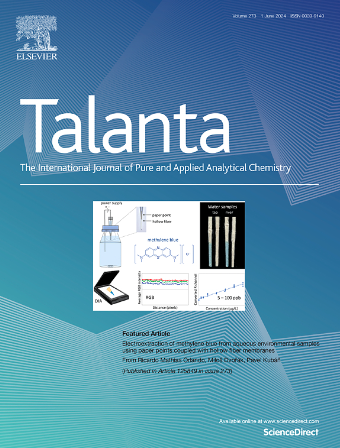Enhanced quenching efficiency of UiO-66-NH2 over UiO-66 to engineer high-performance fluorescence aptasensor for oxytetracycline monitoring
IF 5.6
1区 化学
Q1 CHEMISTRY, ANALYTICAL
引用次数: 0
Abstract
Oxytetracycline (OTC), a broad class of antibacterial medication, has been widely utilized in poultry husbandry and fish farming. However, the presence of OTC residues in the food has become a matter of great concern. These residues have the potential to induce the emergence and spread of bacterial resistance, which can have far-reaching consequences for public health. In this work, we focused on the comparison of the quenching efficiency of UiO-66 and its amino group-modified counterpart UiO-66-NH2, towards the fluorescence of nitrogen-doped graphene quantum dots (NGQDs) labeled aptamer (NGQDs-apt). It was found that UiO-66-NH2 demonstrated a more potent fluorescence quenching ability towards NGQDs-apt, as high as 98.8 %, compared to 69.7 % for UiO-66 without amino functionalization. This enhanced performance is attributed to the improved interaction between the amino groups on UiO-66-NH2 and the NGQDs-apt, facilitating more effective electron transfer. Consequently, UiO-66-NH2 was selected as the optimal quencher for the development of a highly sensitive aptasensor. This aptasensor demonstrates a quantitative detection range for OTC spanning from 0.001 to 200 μM with an exceptionally low detection limit of 0.25 nM, showing simplicity, accuracy, stability and great potential for antibiotic residue detection in food samples. This work addresses the urgent need to develop reliable methods for detecting OTC residues in food due to the potential of OTC to trigger bacterial resistance, which is crucial for food safety and public health.

求助全文
约1分钟内获得全文
求助全文
来源期刊

Talanta
化学-分析化学
CiteScore
12.30
自引率
4.90%
发文量
861
审稿时长
29 days
期刊介绍:
Talanta provides a forum for the publication of original research papers, short communications, and critical reviews in all branches of pure and applied analytical chemistry. Papers are evaluated based on established guidelines, including the fundamental nature of the study, scientific novelty, substantial improvement or advantage over existing technology or methods, and demonstrated analytical applicability. Original research papers on fundamental studies, and on novel sensor and instrumentation developments, are encouraged. Novel or improved applications in areas such as clinical and biological chemistry, environmental analysis, geochemistry, materials science and engineering, and analytical platforms for omics development are welcome.
Analytical performance of methods should be determined, including interference and matrix effects, and methods should be validated by comparison with a standard method, or analysis of a certified reference material. Simple spiking recoveries may not be sufficient. The developed method should especially comprise information on selectivity, sensitivity, detection limits, accuracy, and reliability. However, applying official validation or robustness studies to a routine method or technique does not necessarily constitute novelty. Proper statistical treatment of the data should be provided. Relevant literature should be cited, including related publications by the authors, and authors should discuss how their proposed methodology compares with previously reported methods.
 求助内容:
求助内容: 应助结果提醒方式:
应助结果提醒方式:


